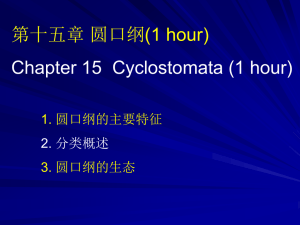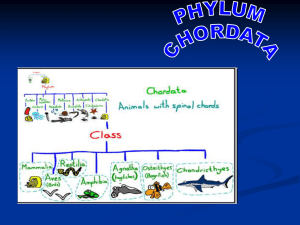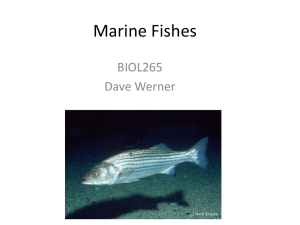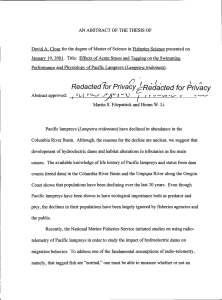Document 11110736
advertisement
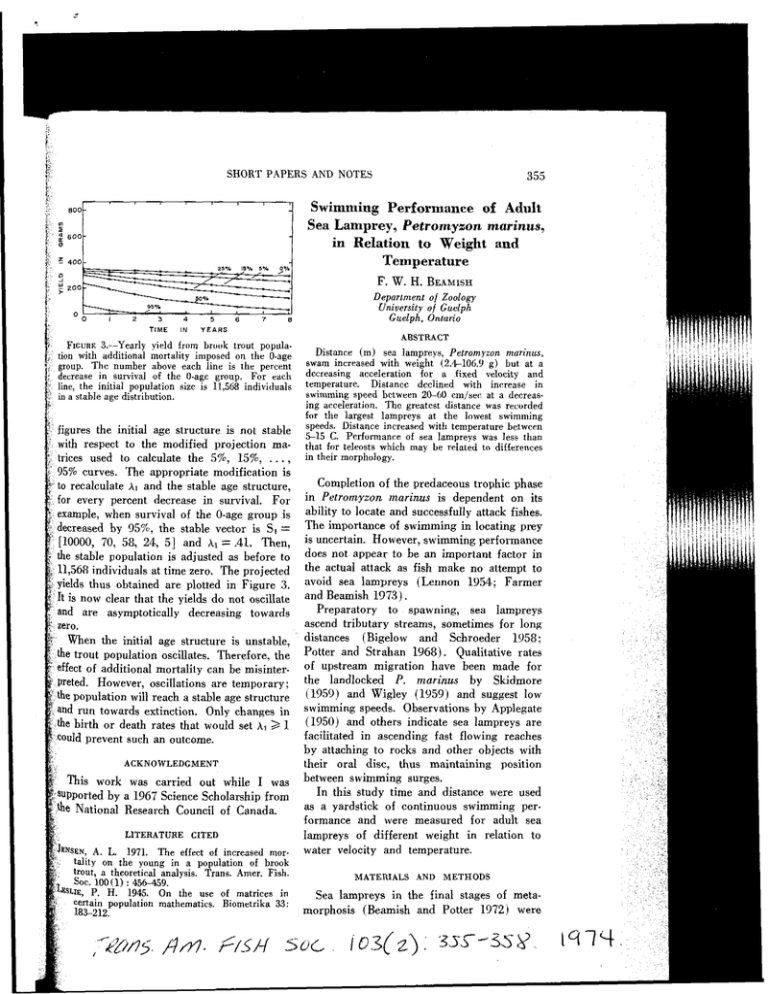
Swimming Performance of Adult Sea Lamprey, Petromyzon marinus, in Relation, to Veight and Temperature F. W. H. BEAMISH 1. TIME IN YEARS FIGIIRF. 3.--Yearly yirld from brook trout population with additional mortality inlposed on the 0-age group. Thc number above each line is the percent ; decrease in survival of the O-age group. For each line, the initial population sixr is 11,568 individuals in a stable age distribution. figures the initial age structure is no1 stable with respect to the modified projection ma, trices used to calculate the s%, 1570, . . . , ' 95% curves. 'The appropriate modification is to recalculate XI and the stable age structure, for every percent decrease in survival. For example, when survival of the 0-age group is decreased by 95%, the stahle vector is S, = ' [10000, 70, 58, 24, 51 and A1 = .41. Then, the stable population is adjusted as before to 11,568 individuals at time zero. The projected yields thus obtained are plotted in Figure 3. It is now clear that the yields do not oscillate and are asymptotically decreasing towards zero. When the initial age structure is unstable, the trout population oscillates. Therefore, the effect of additional mortali~ycan be misinterpreted. However, oscillations are temporary ; the population will reach a stable age structure and run towards extinction. Only changes in the birth or death rates that would set hl 3 I could prevent such an outcome. : " ACKNOWLEDGMENT This work was carried out while I was Supported by a 1967 Science Scholarship from the National Research Council of Canada. LITERATURE CITED " J A. L. ~ 1971. ~ The ~ effect ~ of , increased martality on the young in a population of hrook trout, a theoretical analysis. Trans. Arner. Fish. Soc. I00 ( 1) : 45&459. P. H. 1945. On the use of matrices in ~ LIE, ' i . / ABSTRACT Distance ( m ) sea lampreys, Petromyzon ~narinus, swam increased with weight (2.4-106.9 g) but at a decreasing acceleration for a fixed velocity and temperature. Distancc dcclined with increase in swinuning speed between 20-00 cm/nec at a dccreasing acceleration. Thc greatest distance was ret:orded for the largest lampreys at the lowest swimming speeds. Distance increased with temperature bctwcrn S-15 C. Pcrformancr: of sea lampreys was less ttmn that for teleosts which may be related to differences in thcir morphology. Completion of the predaceous troahic ~ h a s e in Petromyzon rnarinus is dependent on its ability to locate and successfully attack fishes. The importance of swimming in locating prey is uncertain. However, swimming performance does not appear to be an imporlant factor in the actual attack as fish make no attempt to avoid sea lampreys (Lemon 1954; Farmer and Beamish 1973). Preparatory to spawning, sea lampreys ascend tributary streams, sometimes for long distances (Bigelow and Schroeder 1058: Potter and Strahan 1968). Qualitative rates of upstream migration have been made for the landlocked P. marinus by Skidmore (1959) and Wigley (1959) and suggest low swimming speeds. Observations by Applegate (1950) and others indicate sea lampreys are facilitated in ascending fast flowing reaches by attaching to rocks and other objects with their oral disc, thus maintaining position between swimming surges. In this study time and distance were used as a ~ardstickof continuous swimming performance and were measured for adult sea lampreys of different weight in relation to water velocity and temperature. - MATERIALS A N D METHODS Sea lampreys in the final stages of metamorphosis (Beamish and Potter 1912) were S O L 1#&(2) * 35%rd3S Y 356 TRANS. AMER. FISH. SOC., 1974, NO. 2 collected during the autumn of 1970 and 1971 by electrofishing from Shelter Valley Creek, a tributary of Lake Ontario. Adult lampreys were maintained at 10 1 C in 1200- and 2000-liter circular tanks supplied with aerated well water and exposed to a photoperiod of 16 hr. They were allowed to feed a d libitum on white suckers Catostonius commersoni, carp Cyprinus carpio, and rainbow trout Salmo gairdncri for at least 2 months beFore being used for experimentation. Before sea lampreys were used in an experiment they were acclimated to a fixed temperature by a daily change of one degree and allowed at least 2 wreks at the desired temperature. Lampreys were deprived of food for 4 days before the slart of an experiment to assure complete evacuation of the digestive tract. Oxygen contenl in holding tanks was kept at 90-100% of air saturation and ammonia N generally was below 0.1 mg/liter. Swimming performance was determined in [he chamber described in Farmer and Beamish (1969). Briefly, water is driven by a centrifugal pump inlo an expansion chamber in which are located a series of flow "straighteners," through a reduction cone, and into the portion of the chamber in which lampreys were Iorced to swim. Velocity profile in the swimming chamber was rectilinear and essentially constant. I discouraged lampreys from attaching to the inner surface of the swimming chamber by lining it with one layer of fine and one of coarse mesh screening. Sea lampreys to be tested were placed in the chamber and water velocity steadily increased to the desired speed. Gentle prodding was used sometimes to induce lampreys to swim. The time a sea lamprey swam at a fixed velocity was used to calculate distance. When a sea lamprey was fatigued, it was forced against the end screen. Usually the onset of fatigue was obvious. The chamber water was continually exchanged with that from a well aerated reservoir. Dissolved oxygen in the swimming chamber did not fall below 90% of air saturation. After a test, the sea lamprey was removed, weighed and measured to the nearest 0.1 g and 1 mm, respectively. The temperature range examined was 5- * 15 C. At each temperature performance was determined for velocities from 30-60 cm/sec. No fewer than 10 lampreya were used at each swimming speed and lemperature. Wt:ight and length of the 160 lampreys used ranged from 2A-106.9 g and 12.3-14.:: cm, respec. lively. RESULTS AND DISCUSSION Swimming performance was not enhanced by training procedures such as those employed hy Brett (1964) or Farmer and Beamish (1960). The length of time sea lampreys of different weight swam in relation to water velocity and temperature is represented by the equation: log Y = 2.9148 -t0.4975 log XIf 0.0294 X:! - 0.0360 Xa where Y is time in seconds XI is weight in g X2 is temperature in C --\->" XRis swimming speed in cm/sec 15 The correlation coefficient R, for XI,Xz, and Xs was 0.837, significant at P > 0.01. The time sea Iampreys were able to swim steadily at a given speed and temperature increased approximately as the square root of their weight. As speed increased the logarithm of time a lamprey swam decreased at a rake of 0.0380, provided weight and temperature were held constant. Thus, for a given temperature, maximum time of swim ming was recorded for the largest lampreys at the lowest speeds. The logarithm of time for a sea lamprey of a particular weight at a fixed speed increased with temperature at a rate of 0.02'34. The inIluence of weight (length), swimming speed, and temperature on distance sea lampreys swam is presented in Fig. 1. Quantitative measurements of the swimmine performance of adult lampreys, irrespective of species, are particularly scarce, the o b w vations of R. W. McCauley and J. I?. skidmore (personal communication) on swimming speeds of nonfeeding migrating P. marinus (38 cm) preparatory to spawning being a notable exception. They determined the maxi- 25 35 Body Length, ct FICUHE 1.-Distance to speed, body weight, panel distance at di pressed as body lcng relation to body lengt. mum speed sea lan I-min period at 2 sustained speed at that at 2 C, 23.0 tances of 21.3 and the present study st but still actively fet the equation to be ; 35.5 cm/sec and 15 crn/sec and 2 C. P this difference can fluence of food dep migration on the d Large sea lampre: individuals at speec (RL) per second swimming speeds ab favors the smaller s ti011 in relative pe in size of lamprey is observations of BI t SHORT PAPERS AND NOTES 357 salmon, Oncorhynchus nerr'ca, and Beamish (1970) on largemouth bass, Micropterus s d nzoides. FIGURE 1.-Distance sra lan~prey~ swam in relalion speed, body weight, and tcnlperature. 111 the lower panel distancc at different swin~ming speeds, expressed as body lcngth (BI.)/sec, is presented in relation to body length. to mum speed sea lampreys could sustain for ? 1-min period at 2 and 15 C. Tkc maximum sustained speed at 15 C was 35.5 cm/sec and that at 2 C, 23.0 cm/sec, equivalent to distances of 21.3 and 13.8 m, respectively. In the present study sea lampreys oC similar size but still actively feeding were estimated from the equation to be able to swim for 315 m at 35.5 cm/sec and I 5 C and for 250 m at 23.0 cm/sec and 2 C. Presumably at least part of this difference can be attributed to the influence of food deprivation and the spawning migration on the depletion of energy stores. Large sea lampreys swam farther than small individuals at speeds under one body length (BL) per second (Fig. 1 ) . However at swimming speeds above 1 BL/sec performance favors the smaller sea lampreys. This reduction in relative performance with increase in size of lamprey is in accord with the earlier observations of Brett (1965) on sockeye In teleos~s the increase in performance continues to an optimum temperature and thereafter declines (Brett 1964,1965; Beamish 1966, 1970). Performance of sea lampreys which was highest at 15 C was not determined above this temperature on account of the high mortality rate among the larger indivicluals. Sea lampreys are poor swimmers in comparison with most species of teleosts. Sockcya salmon (18 cm) are able to sustain speeds of slightly over 70 cmjsec at 15 C for periods of at least A0 min (Brett l 9 M ) . Maximum sustained speeds (30 min) for largemouth bass of similar length varied from 30 cm/sec at 10 C to 52 cm/sec at 30 C (Beamish 1970). Sea lampreys of 18 cm were estimated to be able to sustain swimming speeds of about 1 cm/sec for 30 min at 15 C and less at 5 C. Further in a study on the swimming endurance of a numher of marine teleosts (Beamish 1966), all were able to swim for longer periods at higher speeds than those found lor sea lampreys. Rates of upstream migration reported for sea lampreys corrobora~ethe present ohservations on their poor performance. Where the mairistrearn flow is rapid, sea lampreys move upstream near the edges (Hardlsty and Potter 1971) where they may be assisted by eddy currents. In he slow flowing regions of Cayuga Inlet, Wigley (1959) reported an average rate of upstream migration of under 5 cm/sec which was in accord with the observations of Skidmore (1959) for the same species in the Pancake River, a tributary of Lake Superior. The anadromous Lampetra fluviatilis appears to be a stronger swimmer and rates of over 100 cm/sec (2.51 BL/sec) have been reported by Abakumnv (1956) during the initial stages 01 migration from the Gulf of Riga. During the later stages of migration rates decreased to 20-40 cm/sec. A number of factors may contribute to the poor performance recorded by sea lampreys. The absence ol a hydrostatic organ requires the expenditure of additional energy to maintain position in a column of water. Stability TRANS. AMER. FISH. SOC., 1974, NO. 358 in lamarevs is reduced as a result of the " absence of mired fins which in teleosts and elasmobranchs serve as hydroplanes. Recause . . of poorly developed ventral and caudal fins posterior turbulence is probably higher than that in most anguilliform fishes. The reduced caudal fin would not appear well adapted for providing a propulsive thrust. Recent information on the active oxygen consumption of adult sea lampreys (Reamish 1973) suggests it is well within the range found for teleosts. ACKNOWLEDGMENTS The technical assistance of Mrs. Elizabeth Thomas is gratefully appreciated. Financial aid was made available by the Nalional Research Council of Canada for studies on the physidogy of migration, this paper representing contribution No. 050. LITERATURE CITED ABAKUMOV, V. A. 1956. LThc mode of lifr of the Baltic river lamprey]. Vopr. Ikhtiol. 16: 12b133. [In Russian1 APPLEGATE, V. C. 1950. Natural history of the sea lamprey, P~tromyaonmarinus in Michigan. U.S. Fish Wildl. Srrv., Spec. Sci. Rep. Fish No. 55: 1-237. REAMISH, F. W. H. 1Shh. Swimming endurance of some Northwest Atlantir fishes. J. Fish. Rrs. Board Can. 23: 341-347. 1970. Oxygen consumption of largcmouth bass, Micropterm salnaoides, in relation to swimming speed and temperature. Can. J. Zobl. 48: 1221-1228. 1973. Oxygen consumption of adult Petrornyzon marinus in relation to body weight and temperature. J. Fish. Rcs. Board Can. 30: 1367-1370. -, A N D I. C. POTTER.1972. Timing of changes in the blood, morphology and hchaviour of Petromyzon murinus during metamorphosis. J. Fish. Res. Board Can. 29: 1277-1282. E~GELOW, H. B., A N D W. C. SCIIROEDER. 1953. Fishes of the Gulf of Maine. U.S. Fish. Wildl. Srrv. Fish. Bull. 53: 1-577. BRETT, J. K. 1964. The respiratory metaholism and swimming perforrnancc of young sockeye salmon. J. Fish. Res. Board Can. 21: 1183-1226. 1965. The relation of size to rate of oxygcn consumption and sustained swimming spccd of sockeye salmon (Oncorhynchus nerkn) J. Fish. Res. Board Can. 22: 1491-1501. FARMER, G. T., A N D F. W. B. HEAMISIT. 1969. Oxygen consumption of Tilapin niloticn (L.) in relation lo swimming speed and salinity. J. Fish. Res. Board Can. 26: 2807-2821. FARMER, G. J., A N D F. W. II. BEAMMI.1973. Predation by t h r sea lamprey, Petromyaon niarinus 2 on freshwater tdeosts. J. Fish. Res. Board Can. 30: 601-605. HARDISTY, M. W., A N D I. C. POTTLR.1971. The gencral biology of adult lampreys, p. 127-206. I n M. W. Bardivty and T. C. Potter (rds.) Thc biology of lampreys, Vol. 1. Acadcmir Press. LENNON, R. E. 1954. Frcding mechanism of thr sea lamprey and its effect on host fishrs. U.S. Fish Wildl. Serv. Fish. Bull. 56: 247-293. POTTER, I. C., A N D R. STRAHAN. 1968. The taxow omy of the lamprcys G C O L ~and Z ~ Mordacia : and their distribution in Australia. Proc. Linn. Snc. 1,nndon 179: 229-210. SKIDMORE, J. F. 1959. Biology of spawning-lun sea lampreys (Petromyzon marinus) in thc Pancake River, Ontario. M.Sc. Thesis, Univ. Western Ontario. WICLEY,R. L. 1959. Life history of the sea lamprey of Cayuga Lake, New York. U.S. Fish Wildl. S e n . Fish. Bull. 59: 559-617. Streptococcus sp. from Marine Fishes Along the Alabama and Northwest Florida Coast of the Gulf of Mexicd . . . . . Fish Kill Areas Depuqtment of Fisheries and Allied Aquacultur~s Alabama Agricultural Experiment Station Auburn University Auburn, Alnbama 36830 AND S o u t h m t Water Research Labora~ory Environmentul Protection Agency Athens, Georgia 30601 ABSTRACT Fish kills in esluarine bays along the Florida and Alahama Gulf Coast were investigated in August and Scptcmber 1972. Eight species of morihund fish were rxamined. A nonhemolytic, group R, type I b Streplococcus sp. was isolated from over 90% of the fish examined. Parasites and toxicants wcre eliminated as possible causes of the kills. Acute fish epizootics attributable to bacterial infections in estuarine areas are infrequent (Sinderman 1966). Most of the epizootics induced by bacteria in the marine environment have been attributed to Vibrio a n g d larum (Rucker 1959; Sinderrnan 1966) and Project supported by the Southeastern cooperative Fish Disease Project, in part by Sport Fish Rcstoration Funds and Environmental Protection Agency. FIGURE1.-Alabama and sp. Areas where the organis there is one report of I a white perch (Roccus Cheaspeake Bay (Sniesi This paper describes lieved to have been caur infection. Until now s been reported from mar twice from freshwater Sano, and Morimoto : Meyer 1966). The Ala. scribed by Wilkinson, 1 (1973) as a nonhemoly Streptococcus was one from the present study. CASE HIS During the period fro late September 1972, acu occurred in various estu 72-km portion of the n the Gulf of Mexico of 1 (Fig. 1). Kills were i examined at the follow Bay, Escambia Bay, ar Florida; and Soldier 4 (both adjacent to Perd Secour River in Alabar that died included me
